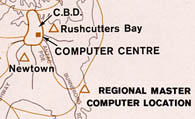
SCATS traffic flow system
1975
computerised traffic light management system
No, this isn't a great Australian fly spray.
SCATS stands for the Sydney Coordinated Adaptive Traffic System. Although it doesn't guarantee green lights all the way, it does reduce delays and improve the overall fuel economy of traffic on city streets around the world.
The unplanned narrow streets of inner Sydney are unusual for a large modern city that relies heavily on car transport. But they are a perfect model for ancient cities whose disordered streets are increasingly clogged with cars.
In the early 1970s the NSW roads authority analysed Sydney's traffic flow and recommended that traffic lights should respond immediately to sudden hiccoughs in flow. In other words they should be able to adapt - and quickly.
Two electronics companies, Philips and AWA Ltd, helped develop the detection, monitoring and signalling techologies used in SCATS. The complex control system changes the timing of traffic lights in response to changes in traffic flow. It manages the normal daily changes from peak hour to off-peak and back. It can also cope with special events, such as concerts and football finals.
SCATS was installed in Sydney in 1974 and has since been installed in more than 30 other car-crowded cities including Dublin, Jakarta, Shanghai, Detroit, Hong Kong and Manila.
Who Did It?
Key Organisations
Roads and Traffic Authority, NSW : R&D, implementation
AWA Ltd : development, manufacture
Philips Traffic Systems Pty Ltd : development, manufacture
Key People
Arthur Sims : systems manager, RTA
Peter Lowrie : traffic engineer, RTA
Mike Woolfe : programmer, Philips
Further Reading
Tomorrow's world: the Australian initiative
Michael Soker et al
Associated Publishing Corporation, Sydney, 1993, pp 72-73.
Links
Roads and Traffic Authority
SCATS - Sydney Coordinated Adaptive Traffic System
Questions & Activities
SCATS traffic flow system
Related Innovations
ATPD pedestrian button
|












